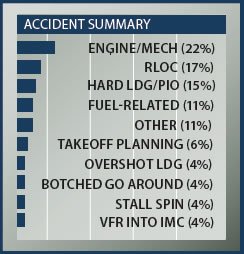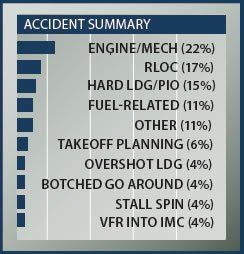Our review of the 100 most recent accidents involving the Beech Musketeer series uncovered very few of the classic poor judgment events such as buzzing (1) and VFR into IMC (4) that we normally see during such accident surveys. Thats the good news.

The bad news is that the Musketeer may take more skill than its peers when it comes to takeoffs and landings-we counted 46 accidents that involved either runway loss of control (RLOC), hard landings (often involving pilot-induced oscillation PIO), landing long and being unable to stop on the runway, hitting an obstruction on takeoff and blown go-arounds. In addition, two of the stall/spin accidents were on short final. We didnt count the nearly half-dozen engine-out forced landings where the pilot stalled the airplane maneuvering for a field.
A significant number of the accidents involved student training-either solo students or students with instructors who werent quite paying close enough attention to what was going on. Nevertheless, with the wide-track landing gear, we were surprised to see as many events in which the pilot lost control after touchdown in a crosswind.
Speed control on final is important in a Musketeer. It may not be very fast in cruise, but it still needs to be slowed down before landing. The number of PIO and runway overshoot accidents indicated to us that extra speed in final is not the Musketeer pilots friend. In many of the accidents, the pilot reported being fast on final, floating and then trying to force the airplane onto the runway, leading to a nosewheel strike and PIO until the gear broke off.
On the other end of the speed on final spectrum, a Musketeer can develop a significant sink rate if flown too slowly. A number of the hard landings came about when the pilot did not arrest a high sink rate with power.
The roomy cabin led to some optimism with regard to loading on the part of two pilots. Both were more than 200 pounds over gross when they tried to take off from modest runways and hit obstructions off the end. In one case, the runway was only 2000 feet long, uphill and the surface consisted of five-inch tall grass.
Half of the engine failure accidents were for unknown reasons; which doesnt provide any warm fuzzies.
The need for caution on the first flight after maintenance was apparent in two accidents-both involved fuel lines that were not correctly reconnected, leading to off-airport landings-one while battling a fire.
The curse of multiple fuel tanks showed up with the Musketeer. Of the 11 fuel-related accidents, seven involved running a tank dry and a forced landing when there was plenty of fuel in the other tank. In only four of the accidents did the pilot exhaust all of the usable fuel. Of those, two pilots made intermediate stops on their flights and didnt take on any more avgas.
One pilot was victimized by a fuel selector installed backward during maintenance.
There were two deer strikes, both at night. In one, the deer took off part of the stabilator during the takeoff roll-the pilot continued the takeoff, flew around the pattern and, despite limited ability to flare, made a hard but safe landing.





